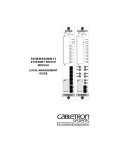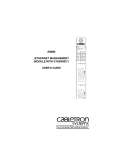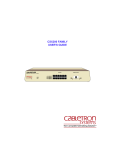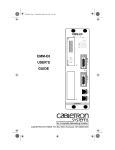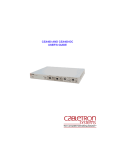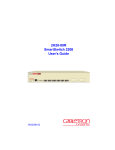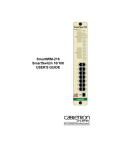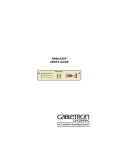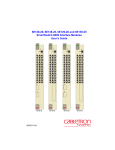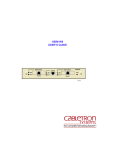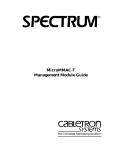Download Cabletron Systems MicroMMAC-42T User`s guide
Transcript
MicroMMAC LOCAL MANAGEMENT USER’S GUIDE NOTICE Cabletron Systems reserves the right to make changes in specifications and other information contained in this document without prior notice. The reader should in all cases consult Cabletron Systems to determine whether any such changes have been made. The hardware, firmware, or software described in this manual is subject to change without notice. IN NO EVENT SHALL CABLETRON SYSTEMS BE LIABLE FOR ANY INCIDENTAL, INDIRECT, SPECIAL, OR CONSEQUENTIAL DAMAGES WHATSOEVER (INCLUDING BUT NOT LIMITED TO LOST PROFITS) ARISING OUT OF OR RELATED TO THIS MANUAL OR THE INFORMATION CONTAINED IN IT, EVEN IF CABLETRON SYSTEMS HAS BEEN ADVISED OF, KNOWN, OR SHOULD HAVE KNOWN, THE POSSIBILITY OF SUCH DAMAGES. Copyright 1996 by Cabletron Systems, Inc., P.O. Box 5005, Rochester, NH 03866-5005 All Rights Reserved Printed in the United States of America Order Number: 9031838-01 June 1996 SPECTRUM, LANVIEW, MicroMMAC, and BRIM are registered trademarks and Element Manager, EPIM, EPIM-A, EPIM-F1, EPIM-F2, EPIM-F3, EPIM-T, EPIM-X, FOT-F, FOT-F3, HubSTACK, SEH, SEHI, and TMS-3 are trademarks of Cabletron Systems, Inc. All other product names mentioned in this manual may be trademarks or registered trademarks of their respective companies. Printed on Recycled Paper MicroMMAC Local Management User’s Guide i Notice FCC NOTICE This device complies with Part 15 of the FCC rules. Operation is subject to the following two conditions: (1) this device may not cause harmful interference, and (2) this device must accept any interference received, including interference that may cause undesired operation. NOTE: This equipment has been tested and found to comply with the limits for a Class A digital device, pursuant to Part 15 of the FCC rules. These limits are designed to provide reasonable protection against harmful interference when the equipment is operated in a commercial environment. This equipment uses, generates, and can radiate radio frequency energy and if not installed in accordance with the operator’s manual, may cause harmful interference to radio communications. Operation of this equipment in a residential area is likely to cause interference in which case the user will be required to correct the interference at his own expense. WARNING: Changes or modifications made to this device which are not expressly approved by the party responsible for compliance could void the user’s authority to operate the equipment. DOC NOTICE This digital apparatus does not exceed the Class A limits for radio noise emissions from digital apparatus set out in the Radio Interference Regulations of the Canadian Department of Communications. Le présent appareil numérique n’émet pas de bruits radioélectriques dépassant les limites applicables aux appareils numériques de la class A prescrites dans le Règlement sur le brouillage radioélectrique édicté par le ministère des Communications du Canada. VCCI NOTICE This equipment is in the 1st Class Category (information equipment to be used in commercial and/or industrial areas) and conforms to the standards set by the Voluntary Control Council for Interference by Information Technology Equipment (VCCI) aimed at preventing radio interference in commercial and/or industrial areas. Consequently, when used in a residential area or in an adjacent area thereto, radio interference may be caused to radios and TV receivers, etc. Read the instructions for correct handling. ii MicroMMAC Local Management User’s Guide Notice CABLETRON SYSTEMS, INC. PROGRAM LICENSE AGREEMENT IMPORTANT: Before utilizing this product, carefully read this License Agreement. This document is an agreement between you, the end user, and Cabletron Systems, Inc. (“Cabletron”) that sets forth your rights and obligations with respect to the Cabletron software program (the “Program”) contained in this package. The Program may be contained in firmware, chips or other media. BY UTILIZING THE ENCLOSED PRODUCT, YOU ARE AGREEING TO BECOME BOUND BY THE TERMS OF THIS AGREEMENT, WHICH INCLUDES THE LICENSE AND THE LIMITATION OF WARRANTY AND DISCLAIMER OF LIABILITY. IF YOU DO NOT AGREE TO THE TERMS OF THIS AGREEMENT, PROMPTLY RETURN THE UNUSED PRODUCT TO THE PLACE OF PURCHASE FOR A FULL REFUND. CABLETRON SOFTWARE PROGRAM LICENSE 1. LICENSE. You have the right to use only the one (1) copy of the Program provided in this package subject to the terms and conditions of this License Agreement. You may not copy, reproduce or transmit any part of the Program except as permitted by the Copyright Act of the United States or as authorized in writing by Cabletron. 2. OTHER RESTRICTIONS. You may not reverse engineer, decompile, or disassemble the Program. 3. APPLICABLE LAW. This License Agreement shall be interpreted and governed under the laws and in the state and federal courts of New Hampshire. You accept the personal jurisdiction and venue of the New Hampshire courts. EXCLUSION OF WARRANTY AND DISCLAIMER OF LIABILITY 1. EXCLUSION OF WARRANTY. Except as may be specifically provided by Cabletron in writing, Cabletron makes no warranty, expressed or implied, concerning the Program (including its documentation and media). CABLETRON DISCLAIMS ALL WARRANTIES, OTHER THAN THOSE SUPPLIED TO YOU BY CABLETRON IN WRITING, EITHER EXPRESSED OR IMPLIED, INCLUDING BUT NOT LIMITED TO IMPLIED WARRANTIES OF MERCHANTABILITY AND FITNESS FOR A PARTICULAR PURPOSE, WITH RESPECT TO THE PROGRAM, THE ACCOMPANYING WRITTEN MATERIALS, AND ANY ACCOMPANYING HARDWARE. 2. NO LIABILITY FOR CONSEQUENTIAL DAMAGES. IN NO EVENT SHALL CABLETRON OR ITS SUPPLIERS BE LIABLE FOR ANY DAMAGES WHATSOEVER (INCLUDING, WITHOUT LIMITATION, DAMAGES FOR LOSS OF BUSINESS, PROFITS, BUSINESS INTERRUPTION, LOSS OF BUSINESS INFORMATION, SPECIAL, INCIDENTAL, CONSEQUENTIAL, OR RELIANCE DAMAGES, OR OTHER LOSS) ARISING OUT OF THE USE OR INABILITY TO USE THIS CABLETRON PRODUCT, EVEN IF CABLETRON HAS BEEN ADVISED OF THE POSSIBILITY OF SUCH DAMAGES. BECAUSE SOME STATES DO NOT ALLOW THE EXCLUSION OR LIMITATION OF LIABILITY FOR CONSEQUENTIAL OR INCIDENTAL DAMAGES, OR ON THE DURATION OR LIMITATION OF IMPLIED WARRANTIES, IN SOME INSTANCES THE ABOVE LIMITATIONS AND EXCLUSIONS MAY NOT APPLY TO YOU. MicroMMAC Local Management User’s Guide iii Notice UNITED STATES GOVERNMENT RESTRICTED RIGHTS The enclosed product (a) was developed solely at private expense; (b) contains “restricted computer software” submitted with restricted rights in accordance with Section 52227-19 (a) through (d) of the Commercial Computer Software - Restricted Rights Clause and its successors, and (c) in all respects is proprietary data belonging to Cabletron and/or its suppliers. For Department of Defense units, the product is licensed with “Restricted Rights” as defined in the DoD Supplement to the Federal Acquisition Regulations, Section 52.227-7013 (c) (1) (ii) and its successors, and use, duplication, disclosure by the Government is subject to restrictions as set forth in subparagraph (c) (1) (ii) of the Rights in Technical Data and Computer Software clause at 252.227-7013. Cabletron Systems, Inc., 35 Industrial Way, Rochester, New Hampshire 03867-0505. iv MicroMMAC Local Management User’s Guide CONTENTS CHAPTER 1 INTRODUCTION 1.1 Using This Manual....................................................................... 1-1 1.2 Manual Organization ................................................................... 1-1 1.3 Local Management Overview ...................................................... 1-2 1.3.1 The Management Agent ................................................. 1-2 1.3.2 In-Band vs. Out-of-Band ................................................. 1-3 1.3.3 Local vs. Remote Management ...................................... 1-3 1.4 Local Management Requirements............................................... 1-3 1.5 Local Management Screen Elements.......................................... 1-4 1.6 Local Management Keyboard Conventions................................. 1-6 1.7 Navigating Local Management Screens...................................... 1-7 1.8 Document Conventions ............................................................... 1-8 1.9 Related Documents ..................................................................... 1-8 1.10 Getting Help................................................................................. 1-8 CHAPTER 2 LOCAL MANAGEMENT REQUIREMENTS 2.1 Configuring a Local Management Terminal................................. 2-1 2.2 Management Terminal Setup Requirements............................... 2-2 2.2.1 Cable Configuration for the Management Terminal ........ 2-3 2.2.2 Cable Configuration for the UPS .................................... 2-4 2.3 Establishing a Telnet Connection ................................................ 2-4 CHAPTER 3 ACCESSING LOCAL MANAGEMENT 3.1 Using the Menu Screens ............................................................. 3-1 3.2 Navigating Local Management Screens...................................... 3-2 3.2.1 Selecting Local Management Menu Screen Items ......... 3-3 3.2.2 Exiting Local Management Screens ............................... 3-4 3.2.3 Exiting the Local Management Session.......................... 3-4 3.3 The Main Menu Screen ............................................................... 3-5 3.4 The Setup Menu Screen.............................................................. 3-6 3.5 The Status Menu Screen............................................................. 3-7 MicroMMAC Local Management User’s Guide v Contents CHAPTER 4 SYSTEM LEVEL SCREEN 4.1 System Level Screen Fields ........................................................4-2 4.2 Setting the System Date ..............................................................4-4 4.3 Setting the System Time ..............................................................4-5 4.4 Setting the Host IP Address.........................................................4-5 4.5 Setting the Out of Band IP Address .............................................4-6 4.6 Setting the Default Gateway ........................................................4-6 4.7 Setting the Subnet Mask..............................................................4-7 4.8 Setting the Default Interface ........................................................4-7 4.9 COM Port Applications.................................................................4-8 4.9.1 Configuring the COM Ports .............................................4-8 4.9.2 Configuring the COM Port Baud Rate .............................4-9 CHAPTER 5 SNMP COMMUNITY NAMES SCREEN 5.1 Community Name Access Policy .................................................5-2 5.2 Setting SNMP Community Names ...............................................5-2 CHAPTER 6 SNMP TRAPS SCREEN 6.1 Trap Table Screen Fields.............................................................6-2 6.2 Setting the SNMP Trap Destination .............................................6-2 CHAPTER 7 FLASH DOWNLOAD SCREEN 7.1 Selecting a Flash Download Method ...........................................7-2 7.1.1 Runtime Download ..........................................................7-2 7.1.2 Bootprom Download........................................................7-3 CHAPTER 8 BRIDGE SETUP SCREEN 8.1 Bridge Setup Screen Fields .........................................................8-2 8.2 Selecting a Spanning Tree Protocol ............................................8-2 8.3 Selecting the Port Administrative Status ......................................8-3 8.4 Selecting the Bridge Port Pair Administrative Status ...................8-4 CHAPTER 9 COMPONENT STATUS SCREEN CHAPTER 10 BRIDGE STATISTICS SCREEN 10.1 Bridge Statistics Screen Fields ..................................................10-1 10.2 Selecting an Update-Freq ..........................................................10-4 10.3 Selecting an Interface/Module/Port............................................10-4 10.4 Enabling Ports............................................................................10-5 10.5 Disabling Ports ...........................................................................10-5 vi MicroMMAC Local Management User’s Guide Contents CHAPTER 11 MIB NAVIGATOR SCREEN 11.1 Managing Device MIBs.............................................................. 11-2 11.2 MIB Navigator Command Set Overview.................................... 11-3 11.2.1 Conventions for MIB Navigator Commands ................. 11-4 11.2.2 Navigation Commands ................................................. 11-5 11.2.3 Other Commands ....................................................... 11-11 11.2.4 Special Commands..................................................... 11-17 MicroMMAC Local Management User’s Guide vii Contents viii MicroMMAC Local Management User’s Guide CHAPTER 1 INTRODUCTION Welcome to the Cabletron Systems MicroMMAC Local Management User’s Guide. This manual explains how to access and use Cabletron Systems Local Management for the MicroMMAC. Local Management provides monitoring and control services for the MicroMMAC and its attached segments. 1.1 USING THIS MANUAL A general working knowledge of basic network operations and an understanding of management applications is helpful prior to using Cabletron Systems Local Management. This manual describes how to: • Access the Local Management application • Identify and operate the types of fields used by Local Management • Navigate through Local Management fields and menus • Use Local Management screens to perform management operations 1.2 MANUAL ORGANIZATION The following summarizes the organization of this manual. Chapter 1, Introduction, outlines the contents of this manual, provides an overview of Local Management, and explains how to use the management screens. Chapter 2, Local Management Requirements, describes the setup requirements for accessing Local Management. It also explains how to configure a management terminal and connect it to the MicroMMAC. Chapter 3, Accessing Local Management, describes how to access the Main Menu screen and navigate the Local Management screens. Chapter 4, System Level Screen, describes how to use the System Level screen, its functions, and operations. MicroMMAC Local Management User’s Guide Page 1-1 Chapter 1: Introduction Chapter 5, SNMP Community Names Screen, explains how to control access to the MicroMMAC by assigning community names. Chapter 6, SNMP Traps Screen, explains how to configure the MicroMMAC to send SNMP traps to multiple network management stations. Chapter 7, Flash Download Screen, describes how to download a new firmware image to the MicroMMAC. Chapter 8, Bridge Setup Screen, describes how to configure the MicroMMAC for bridge functions. Chapter 9, Component Status Screen, discusses how to view the status of MicroMMAC MIB components. Chapter 10, Bridge Statistics Screen, discusses how to configure the MicroMMAC to gather statistics for each interface, module, and port. Chapter 11, MIB Navigator Screen, describes how to access and use the MIB Navigator screen. This chapter also includes examples for MIB Navigator commands. 1.3 LOCAL MANAGEMENT OVERVIEW Cabletron Systems Local Management is a management tool that allows a network manager to perform the following tasks: • Configure interconnected devices to form a network • Monitor the performance of the network • Control user access to the network and its components for the purpose of security 1.3.1 The Management Agent The management agent is a processor within the MicroMMAC which collects statistical information (e.g., frames received, errors detected) about the managed network’s operational performance. Local Management communicates with the management agent for the purpose of viewing statistics or issuing management commands to network devices. Page 1-2 MicroMMAC Local Management User’s Guide Local Management Requirements 1.3.2 In-Band vs. Out-of-Band Network management systems are often classified as either in-band or out-of-band. In-band network management passes data along the same medium (cables, frequencies) used by all other stations on the network. An example of an in-band network management system is Cabletron Systems SPECTRUM. Out-of-band network management passes data along a medium that is entirely separate from the network’s common data carrier, for example, a cable connection between a dumb terminal and the COM port of the MicroMMAC. Cabletron Systems Local Management is an out-of-band network management system. A device connected out-of-band to the management agent is not connected to the LAN. This type of connection allows you to communicate with a network device even when that device is unable to communicate through the network, for example, at the time of installation. 1.3.3 Local vs. Remote Management Network management applications are usually described as either local or remote management applications. Local management applications reside within the circuits of the management device’s management agent. Remote management applications run within the circuits of another device that provides management services. This allows you to perform network management from a remote location. 1.4 LOCAL MANAGEMENT REQUIREMENTS The MicroMMAC provides two communication ports. Each port supports a management terminal connection. To access Local Management, connect one of the following systems to either COM 1 or COM 2: • Digital Equipment Corporation VT series terminal • VT type terminal running emulation programs for the Digital Equipment Corporation VT series • IBM or compatible PC running a VT series emulation software package You can also access Local Management using a Telnet connection through one of the network ports of the MicroMMAC. MicroMMAC Local Management User’s Guide Page 1-3 Chapter 1: Introduction 1.5 LOCAL MANAGEMENT SCREEN ELEMENTS Local Management screens consist of five basic elements, or fields. Figure 1-1 shows a Local Management screen and points out the various types of fields. EVENT MESSAGE FIELD DISPLAY FIELDS INPUT FIELDS SELECTION FIELDS SAVED OK Flash Image Version XX.XX.XX MicroMMAC Local Management SYSTEM LEVEL System Date: 01/23/96 Host IP Address Subnet Mask Phys Address COM 1 Application: COM 2 Application: System Time: 14:23:00 000.000.000.000 255.255.0.0 00-00-1D-16-26-F8 Out of Band IP Addr Default Gateway Default Interface 0.0.0.0 NONE DEFINED NONE DEFINED [LM] [UNASSIGNED] SAVE RETURN 090836 COMMAND FIELDS Figure 1-1 Page 1-4 Sample Local Management Screen MicroMMAC Local Management User’s Guide Local Management Screen Elements The following list explains each of the Local Management fields: Event Message Field This field briefly displays messages that indicate if a Local Management procedure was executed correctly or incorrectly, that changes were saved or not saved to Non-Volatile Random Access Memory (NVRAM), or that a user did not have access privileges to an application. Table 1-1 describes the most common event messages. Event messages related to specific Local Management applications are described with those applications throughout this manual. Table 1-1 Event Messages Message Meaning SAVED OK One or more fields were modified, and saved to NVRAM. NOT SAVED?--PRESS SAVE TO KEEP CHANGES One or more fields were modified, but not yet saved to NVRAM. NOTHING TO SAVE The SAVE command was executed, but nothing was saved to NVRAM. Display Fields Display fields can not be edited. These fields may display information which never changes, or information which may change as a result of Local Management operations, user selections, or network monitoring information. Input Fields Input fields require the entry of keyboard characters. IP addresses, System Date, and System Time are examples of Input fields. Selection Fields Selection fields provide a series of possible values. Only applicable values appear in selection fields. Command Fields Command fields are located at the bottom of Local Management screens. Command fields are used to exit Local Management screens and to save Local Management entries. MicroMMAC Local Management User’s Guide Page 1-5 Chapter 1: Introduction 1.6 LOCAL MANAGEMENT KEYBOARD CONVENTIONS All key names appear in this manual as capital letters. For example, the Enter key appears as ENTER, the Escape key appears as ESC, and the Backspace key appears as BACKSPACE. Table 1-2 explains the keyboard conventions used in this manual as well as the key functions. Table 1-2 Keyboard Conventions Key Function ENTER and RETURN These are selection keys that perform the same Local Management function. For example, “Press ENTER” means that you can press either ENTER or RETURN, unless this manual specifically instructs you otherwise. ESC This key lets you escape from a Local Management screen without saving your changes. For example, “Press ESC twice” means that you must quickly press the ESCAPE key two times to exit the Local Management screen. SPACE and BACKSPACE These keys cycle through selections in some Local Management fields. Press SPACE to cycle forward through selections and Press BACKSPACE to cycle backward through selections. Arrows These are navigation keys. Use the UP-ARROW, DOWN-ARROW, LEFT-ARROW, and RIGHT-ARROW keys to move the screen cursor. For example, “Use the arrow keys” means to press whichever arrow key moves the cursor to the desired field on the Local Management screen. SHIFT-[+/=] Page 1-6 This key combination increments values in some Local Management selection fields. For example, “Press SHIFT-[+/=]” means to hold down the SHIFT key while pressing the PLUS/EQUAL key. MicroMMAC Local Management User’s Guide Navigating Local Management Screens Table 1-2 [–] DEL Keyboard Conventions (Continued) This key decreases values from some Local Management selection fields. For example, “Press [–]” means to press the MINUS key. The DEL (Delete) key removes characters from a Local Management Selection field. For example, “Press DEL” means to press the DELETE key. 1.7 NAVIGATING LOCAL MANAGEMENT SCREENS To navigate within a Local Management screen, use the arrow keys of the terminal or the workstation providing terminal emulation services. The Local Management screen cursor responds to the LEFT-ARROW, RIGHT-ARROW, UP-ARROW, and DOWN-ARROW keys. Each time you press an arrow key, the Local Management screen cursor moves to the next available field in the direction of the arrow key. The Local Management screen cursor only moves to fields which can be selected or used for input. This means that the cursor jumps over display fields and empty lines on the Local Management screen. The Local Management screen cursor provides wrap-around operation. This means that a cursor located at the edge of a screen, when moved in the direction of that edge, “wraps around” to the outermost selectable item on the opposite side of the screen which is on the same line or column. MicroMMAC Local Management User’s Guide Page 1-7 Chapter 1: Introduction 1.8 DOCUMENT CONVENTIONS The following conventions are used throughout this document: NOTE TIP ! Note symbol. Calls the reader’s attention to any item of information that may be of special importance. Tip symbol. Conveys helpful hints concerning procedures or actions. Caution symbol. Contains information essential to avoid damage to the equipment or poor network performance. CAUTION 1.9 RELATED DOCUMENTS Use the following manuals to supplement the procedures and other technical data provided in this manual. The procedures contained in the following manuals are referenced where appropriate, but not repeated in this manual. • Cabletron Systems MicroMMAC 10BASE-T Intelligent Stackable Hub Installation Guide • Cabletron Systems BRIM User's Guides 1.10 GETTING HELP If you need additional support related to Local Management, or if you have any questions, comments, or suggestions concerning this manual, contact Cabletron Systems Technical Support: By phone By CompuServe By Internet mail By FTP Login Password Page 1-8 (603) 332-9400 Monday – Friday; 8 A.M. – 8 P.M. Eastern Time GO CTRON from any ! prompt [email protected] ctron.com (134.141.197.25) anonymous your email address MicroMMAC Local Management User’s Guide Getting Help Before calling Cabletron Systems Technical Support, have the following information ready: • A description of the failure • A description of any action(s) already taken to resolve the problem (e.g., changing mode switches, rebooting the unit, etc.) • A description of your network environment (layout, cable type, etc.) • Network load and frame size at the time of trouble (if known) • The serial and revision numbers of all Cabletron Systems products in the network • The device history (i.e., have you returned the device before, is this a recurring problem, etc.) • Any previous Return Material Authorization (RMA) numbers MicroMMAC Local Management User’s Guide Page 1-9 Chapter 1: Introduction Page 1-10 MicroMMAC Local Management User’s Guide CHAPTER 2 LOCAL MANAGEMENT REQUIREMENTS This chapter describes how to attach a Local Management terminal to the Cabletron Systems host device, and lists the setup and configuration requirements for the following equipment: • Console/terminal • Console cable • Console cable connections 2.1 CONFIGURING A LOCAL MANAGEMENT TERMINAL The following instructions explain how to configure your management terminal (console) to communicate with Local Management. Refer to your specific management terminal manual for more instructions if necessary. To access Local Management, use one of the following systems: • Digital Equipment Corporation VT series terminal • VT type terminal running emulation programs for the Digital Equipment Corporation VT series • IBM or compatible PC running a VT series emulation software package MicroMMAC Local Management User’s Guide Page 2-1 Chapter 2: Local Management Requirements 2.2 MANAGEMENT TERMINAL SETUP REQUIREMENTS Table 2-1 lists the setup parameters for the management terminal. If the management terminal is a Digital Equipment Corporation VT320 terminal, press F3 to access the Setup Directory. If the management terminal uses terminal emulation of the VT320, refer to the equipment user manual for setup procedures. Table 2-1 Terminal Setup Parameters Menu Function Selection Display Setup Columns 80 Columns Controls Interpret Controls Auto Wrap No Auto Wrap Test Cursor Cursor Mode 7 Bit Control Cursor Keys Normal Cursor Keys Transmit Transmit = 9600 General Setup Communications Setup Keyboard Setup Page 2-2 Receive Receive = Transmit XOFF any option Bits, Parity 8 Bits, No Parity Stop Bit 1 Stop Bit Local Echo No Local Echo Port DEC-423, Data Leads Only Transmit any option Auto Answerback No Auto Answerback Auto Repeat any option Keyclick any option Margin Bell Margin Bell Warning Bell Warning Bell Auto Answerback No Auto Answerback MicroMMAC Local Management User’s Guide Management Terminal Setup Requirements 2.2.1 Cable Configuration for the Management Terminal This section outlines the proper cable configurations to connect a management terminal to the MicroMMAC. You need an adapter kit containing the following items to connect a terminal to the MicroMMAC: • One RS232 cable • One VT series adapter • One VT series device cable The adapter you use depends on whether you connect a VT320 terminal or a PC emulating a VT320 to the MicroMMAC COM port. Read the information included with the adapter kit to make sure that you are using the correct adapter. To configure the cables, perform the following steps: 1. Plug a straight-through twisted pair cable (e.g., an RS232 cable) into the MicroMMAC’s COM 1 or COM 2 port. 2. Plug the other end of the RS232 cable into the adapter. 3. Connect the adapter into the VT series device cable and plug the other end of the VT series device cable into the terminal. 4. Power on the terminal. The message “VT320 OK” appears on the screen indicating that the cables are properly configured to the VT terminal. MicroMMAC Local Management User’s Guide Page 2-3 Chapter 2: Local Management Requirements 2.2.2 Cable Configuration for the UPS To configure a cable from the Uninterruptible Power Supply (UPS) to a host device perform the following steps: 1. Plug a straight-through twisted pair, RS232, cable into the COM 1 or COM 2 port. 2. Plug the other end of the RS232 cable into the adapter (Part No. 9372066) and connect the adapter to the UPS. After the cable configuration is complete, use one of the following management tools to configure the COM port for UPS application: • Local Management – Chapter 4, System Level Screen of this manual provides instructions for setting up the COM 1 and COM 2 ports for the UPS application. • Graphical user interfaces provided by SPECTRUM Element Manager for Windows, SPECTRUM Portable Management Applications (SPMAs), or SPECTRUM software packages. 2.3 ESTABLISHING A TELNET CONNECTION Once the MicroMMAC has a valid IP address, you can establish a Telnet session with Local Management from any TCP/IP based node on the network. Telnet connections to the host device require the community name passwords assigned at the SNMP Community Names screen. Refer to the SNMP Community Names section of this manual for additional information about community names. NOTE Page 2-4 See the instructions included with the Telnet application for information about establishing a Telnet session. MicroMMAC Local Management User’s Guide CHAPTER 3 ACCESSING LOCAL MANAGEMENT This chapter explains how to access and use the Local Management menu screens. Menu screens provide a path to the setup screens, statistic screens, and status screens. 3.1 USING THE MENU SCREENS Verify that your terminal has been properly connected to the MicroMMAC before proceeding. To access Local Management, perform the following steps: 1. Power on the terminal. The message “VT320 OK” appears on the terminal screen. 2. Press RETURN two times. The first RETURN activates Auto-Baud Detection and the second RETURN displays the MicroMMAC Password screen, Figure 3-1. MicroMMAC Local Management CABLETRON Systems, Incorporated P.O. Box 5005 Rochester, NH (603) 03867-5005 USA 332-9400 (c) Copyright CABLETRON Systems, Inc. 19XX Flash Image Version: XX.XX.XX BOOTPROM Version: XX.XX.XX Board Revision: X.X Enter Password: 090820 Figure 3-1 The MicroMMAC Password Screen MicroMMAC Local Management User’s Guide Page 3-1 Chapter 3: Accessing Local Management 3. Enter your password and press ENTER. The default super-user access password is “public” or press ENTER. NOTE Your password is one of the community names specified in the SNMP Community Names screen. Access to certain Local Management capabilities depends on the degree of access accorded that community name. See the SNMP Community Names section. • If you enter an invalid password the cursor returns to the beginning of the password entry field. • If you enter a valid password, the associated access level displays at the bottom of the screen and the Main Menu screen, Figure 3-3, appears. • If no activity occurs for several minutes the Password screen reappears indicating that you must re-enter the password. 3.2 NAVIGATING LOCAL MANAGEMENT SCREENS Local Management consists of a series of menu screens that provide a path to each of the Local Management function screens. You navigate through Local Management by selecting items from the menu screens. MicroMMAC Local Management consists of the following menu screens: • Main Menu screen • Setup Menu screen • Status Menu screen • Statistics Menu screen Figure 3-2 shows the hierarchy of Local Management screens. Page 3-2 MicroMMAC Local Management User’s Guide Navigating Local Management Screens Setup Menu Password System Level SNMPCommunity Names SNMP Traps Flash Download Bridge Setup Main Menu Status Menu Component Status Statistics Menu Bridge Statistics MIB Navigator 090830 Figure 3-2 Hierarchy of Local Management Screens 3.2.1 Selecting Local Management Menu Screen Items To select items on a Local Management menu screen, perform the following steps: 1. Use the arrow keys to highlight a menu item. 2. Press ENTER. The selected Local Management menu screen appears. MicroMMAC Local Management User’s Guide Page 3-3 Chapter 3: Accessing Local Management 3.2.2 Exiting Local Management Screens To exit any of the Local Management screens, perform the following steps: 1. Use the arrow keys to highlight the RETURN command at the bottom of the Local Management screen. 2. Press ENTER. The previous screen in the Local Management hierarchy appears. NOTE You can also exit Local Management screens by pressing ESC twice. This exit method does not warn you about unsaved changes and all unsaved changes will be lost. 3.2.3 Exiting the Local Management Session To exit from MicroMMAC Local Management, perform the following steps: 1. Use the arrow keys to highlight the RETURN command at the bottom of the Local Management screen. 2. Press ENTER. The previous screen in the Local Management hierarchy appears. 3. Repeat steps 1 and 2 until the Main Menu screen appears. 4. Use the arrow keys to highlight the EXIT command at the bottom of the Main Menu screen. 5. Press ENTER. The MicroMMAC Local Management Password screen appears and the Local Management session ends. Page 3-4 MicroMMAC Local Management User’s Guide The Main Menu Screen 3.3 THE MAIN MENU SCREEN The Main Menu screen is the starting point from which all the Local Management screens are accessed. Figure 3-3 shows the Main Menu screen. Event Message Line MicroMMAC Local Management Flash Image Version: XX.XX.XX MAIN MENU SETUP MENU STATUS MENU STATISTICS MENU MIB NAVIGATOR EXIT 090821 Figure 3-3 The Main Menu The Main Menu screen displays the following menu items: • Setup Menu – The Setup Menu provides access to Local Management screens that are used to configure the MicroMMAC. • Status Menu – The Status Menu provides access to the Component Status screen which displays the operational and administrative status of MicroMMAC MIB components. • Statistics Menu – The Statistics Menu provides bridge statistics and performance information for devices managed by the MicroMMAC in the network. • MIB Navigator – The MIB Navigator is a Local Management utility which allows the user to access, monitor, and set specific Management Information Base (MIB) items within the MicroMMAC. MicroMMAC Local Management User’s Guide Page 3-5 Chapter 3: Accessing Local Management 3.4 THE SETUP MENU SCREEN The Setup Menu screen provides access to Local Management screens that are used to configure or alter the configuration of the MicroMMAC. Examples of functions accessible through the Setup Menu include configuring the host IP address and subnet mask, assigning SNMP community names, and configuring SNMP trap notification. Figure 3-4 shows the Setup Menu. Event Message Line MicroMMAC Local Management Flash Image Version XX.XX.XX SETUP MENU SYSTEM LEVEL SNMP COMMUNITY NAMES SNMP TRAPS FLASH DOWNLOAD BRIDGE SETUP RETURN 090822 Figure 3-4 The Setup Menu The Setup Menu displays the following menu items (the Flash Download screen and the Bridge Setup screen are discussed later in this manual): • System Level – The System Level Setup screen allows you to configure basic operating parameters for the MicroMMAC. • SNMP Community Names – The SNMP Community Names Setup screen allows you to change or review the community names used as access passwords for local management operation. • SNMP Traps – The SNMP Traps Setup screen provides display and configuration access to the table of IP addresses used for trap destinations and associated community names. Page 3-6 MicroMMAC Local Management User’s Guide The Status Menu Screen 3.5 THE STATUS MENU SCREEN Figure 3-5 shows the Status Menu screen. The Status Menu screen provides access to the Chassis Status screen and Component Status screen. The MicroMMAC does not use the Chassis Status screen. NOTE Event Message Line MicroMMAC Local Management Flash Image Version: XX.XX.XX STATUS MENU CHASSIS STATUS COMPONENT STATUS RETURN 090826 Figure 3-5 The Status Menu Screen MicroMMAC Local Management User’s Guide Page 3-7 Chapter 3: Accessing Local Management Page 3-8 MicroMMAC Local Management User’s Guide CHAPTER 4 SYSTEM LEVEL SCREEN This chapter explains how to use the System Level screen to set the following parameters: • System Date • System Time • Host IP Address • Out of Band IP Address • Subnet Mask • Default Gateway • Default Interface • COM 1 and COM 2 Port Applications MicroMMAC Local Management User’s Guide Page 4-1 Chapter 4: System Level Screen 4.1 SYSTEM LEVEL SCREEN FIELDS Figure 4-1 shows the MicroMMAC System Level screen. Event Message Line MicroMMAC Local Management Flash Image Version XX.XX.XX SYSTEM LEVEL System Date: 12/30/95 Host IP Address Subnet Mask Phys Address COM 1 Application: COM 2 Application: System Time: 14:23:00 000.000.000.000 255.255.0.0 00-00-1D-16-26-F8 Out of Band IP Addr Default Gateway Default Interface [LM] [SLIP] COM2 Baud Rate: 0.0.0.0 NONE DEFINED NONE DEFINED NO_FRAMEWORK_ERROR SAVE RETURN Field Sensitive Help Line 090823 Figure 4-1 The System Level Screen The following definitions explain each System Level screen field. The sections which follow these definitions explain the use of these fields. System Date Use this field to enter the system date. System Time Use this field to enter the system time. Host IP Address Use this field to enter the IP address of the MicroMMAC. Out of Band IP Addr Use this field to enter the out of band IP address for a MicroMMAC communications port (COM 1 or COM 2) configured for a Serial Line Internet Protocol (SLIP) session. Page 4-2 MicroMMAC Local Management User’s Guide System Level Screen Fields Subnet Mask Use this field to enter the subnet mask for the MicroMMAC. Subnets are logical divisions of the network that isolate groups of devices. The subnet mask determines how the MicroMMAC directs SNMP traps to a management workstation. If the MicroMMAC resides on the same network as the management workstation, then the MicroMMAC sends SNMP traps directly to the management workstation. If the MicroMMAC resides on a different subnet as the management workstation, then the MicroMMAC sends SNMP traps to a gateway or router. • Use the subnet mask default setting, 255.255.0.0, when the management workstations designated to receive SNMP traps reside on the same network as the MicroMMAC. • Set a new value for the subnet mask when management workstations designated to receive SNMP traps reside on a different subnet (for example, across a gateway or router). Default Gateway Use this field to enter the default gateway for the MicroMMAC. The default gateway is the IP address of the network device (gateway or router) used to forward SNMP traps to a management station. The default setting for this field is NONE DEFINED. Phys Address This field displays the physical address of the MicroMMAC. You cannot modify the physical address. Default Interface Use this field to select the default interface for the MicroMMAC’s default gateway. The default interface is the channel that is set up to handle SNMP traps sent to an IP station that is not on the same subnet as the MicroMMAC in an IP routed environment. The default setting for this field is NONE DEFINED. COM 1 Application Use this field to select the communication port’s application. Settings for this field are UNASSIGNED, SLIP, UPS, or LM. COM 2 Application Use this field to select the communication port’s application. Settings for this field are UNASSIGNED, SLIP, UPS, or LM. MicroMMAC Local Management User’s Guide Page 4-3 Chapter 4: System Level Screen Baud Rate This field only appears when the COM 1 or the COM 2 Application field is set to SLIP. The default setting for this field is NO_FRAMEWORK_ERROR. The MicroMMAC uses Auto-Baud Detection which automatically detects the Baud rate for the MicroMMAC. 4.2 SETTING THE SYSTEM DATE To set the system date, perform the following steps: 1. Use the arrow keys to highlight the System Date field. 2. Enter the date in a MM/DD/YY format. NOTE When entering the date in the system date field, you do not need to add separators between month, day, and year numbers, as long as each entry uses two decimal numbers. For example, to set the date to 03/17/96, type “031796” in the System Date field. 3. Press ENTER to set the system calendar. 4. Use the arrow keys to highlight the SAVE command at the bottom of the screen and press ENTER. If the date entered was a valid format, the Event Message field at the top of the screen displays “SAVED OK.” If the entry was not valid, Local Management does not alter the current value and refreshes the System Date field with the previous value. Page 4-4 MicroMMAC Local Management User’s Guide Setting the System Time 4.3 SETTING THE SYSTEM TIME To set the system clock, perform the following steps: 1. Use the arrow keys to highlight the System Time field. 2. Enter the time in a 24-hour format, HH:MM:SS. NOTE When entering the time in the system time field, you do not need to add separators between hours, minutes, and seconds, as long as each entry uses two decimal numbers. For example, to set the time to 6:45 a.m., type “064500” in the System Time field. 3. Press ENTER to set the system clock. 4. Use the arrow keys to highlight the SAVE command field at the bottom of the screen and press ENTER. If the time entered was a valid format, the Event Message field at the top of the screen displays “SAVED OK.” If the entry was not valid, Local Management does not alter the current value and refreshes the System Time field with the previous value. 4.4 SETTING THE HOST IP ADDRESS To set the host IP address, perform the following steps: 1. Use the arrow keys to highlight the Host IP Address field. 2. Enter the IP address using Decimal Dotted Notation (DDN) format. For example: 134.141.25.17 3. Press ENTER. If the IP address entered was a valid format, the cursor returns to the beginning of the Host IP Address field. If the entry was not valid, the Event Message field displays “INVALID IP ADDRESS OR FORMAT ENTERED.” Local Management does not alter the current value and refreshes the Host IP Address field with the previous value. 4. Use the arrow keys to highlight the SAVE command field. 5. Press ENTER. The Event Message field at the top of the screen displays “SAVED OK.” MicroMMAC Local Management User’s Guide Page 4-5 Chapter 4: System Level Screen 4.5 SETTING THE OUT OF BAND IP ADDRESS To set the Out of Band IP Address, perform the following steps: 1. Use the arrow keys to highlight the Out of Band IP Addr field. 2. Enter the IP address using Decimal Dotted Notation (DDN) format. For example: 134.141.25.17 3. Press ENTER. If the IP address entered was a valid format, the cursor returns to the beginning of the Out of Band IP Address field. If the entry was not valid, the Event Message field displays “INVALID IP ADDRESS OR FORMAT ENTERED.” Local Management does not alter the current value and refreshes the IP Address field with the previous value. 4. Use the arrow keys to highlight the SAVE command field. 5. Press ENTER. The Event Message field at the top of the screen displays “SAVED OK.” 4.6 SETTING THE DEFAULT GATEWAY To set the default gateway, perform the following steps: 1. Use the arrow keys to highlight the Default Gateway field. 2. Enter the IP address of the default gateway using DDN format. For example: 134.141.79.121 3. Press ENTER. If the default gateway address entered was a valid format, the cursor returns to the beginning of the Default Gateway field. If the entry was not valid, the Event Message field displays “INVALID DEFAULT GATEWAY OR FORMAT ENTERED.” Local Management does not alter the current value and refreshes the Default Gateway field with the previous value. 4. Use the arrow keys to highlight the SAVE command field. 5. Press ENTER. The Event Message field at the top of the screen displays “SAVED OK.” Page 4-6 MicroMMAC Local Management User’s Guide Setting the Subnet Mask 4.7 SETTING THE SUBNET MASK Subnets are logical divisions of the network. To change the subnet mask from its default value, perform the following steps: 1. Use the arrow keys to highlight the Subnet Mask field. 2. Enter the subnet mask using Decimal Dotted Notation (DDN) format. Values for each decimal must range from 0-255. For example: 255.255.0.0 3. Press ENTER. If the subnet mask entered was a valid format, the cursor returns to the beginning of the Subnet Mask field. If the entry was not valid, the Event Message field displays “INVALID SUBNET MASK OR FORMAT ENTERED.” Local Management does not alter the current value and refreshes the Subnet Mask field with the previous value. 4. Use the arrow keys to highlight the SAVE command field. 5. Press ENTER. The Event Message field at the top of the screen displays “SAVED OK.” 4.8 SETTING THE DEFAULT INTERFACE To set the default interface, perform the following steps: 1. Use the arrow keys to highlight the Default Interface field. 2. Enter the interface number for the default gateway in this field. 3. Press ENTER. If the interface entered was a valid format, the cursor returns to the beginning of the Subnet Mask field. If the entry was not valid, the Event Message field displays “PERMISSIBLE RANGE: 1...1.” Local Management does not alter the current value and refreshes the Default Interface field with the previous value. 4. Use the arrow keys to highlight the SAVE command field. 5. Press ENTER. The Event Message field at the top of the screen displays “SAVED OK.” MicroMMAC Local Management User’s Guide Page 4-7 Chapter 4: System Level Screen 4.9 COM PORT APPLICATIONS The MicroMMAC communication ports, COM 1 and COM 2, support the following applications: NOTE Refer to the Release Notes included with the MicroMMAC to verify which communication port applications are currently supported. • Cabletron Systems Local Management connections • American Power Conversion (APC) Uninterruptible Power Supply (UPS) management connections • Telnet connections to a wide area network via the Serial Line Internet Protocol (SLIP) 4.9.1 Configuring the COM Ports To configure the COM 1 and COM 2 ports, perform the following steps: 1. Use the arrow keys to highlight the COM 1 Application or the COM 2 Application field. ! CAUTION Use caution not to alter the settings of the port which is operating the current Local Management connection. This could disconnect the Local Management terminal from the port and end the Local Management session. 2. Press SPACE or BACKSPACE to cycle through the available settings until the operation you require appears. Table 4-1 lists the available settings and their corresponding applications. Page 4-8 MicroMMAC Local Management User’s Guide COM Port Applications Table 4-1 COM Port Application Settings Setting Application LM Local Management Session UPS APC Power Supply SNMP Proxy SLIP Serial Line Internet Protocol UNASSIGNED Not Active 3. Press ENTER. 4. Use the arrow keys to highlight the SAVE command field. 5. Press ENTER. The Event Message field at the top of the screen displays “SAVED OK.” 4.9.2 Configuring the COM Port Baud Rate If you select SLIP as the COM port application, an additional field appears to the right of the port field. This is the Baud Rate field. The Baud Rate field allows the port operating SLIP to be set to the correct baud rate for its modem connection. To alter and set the SLIP baud rate, perform the following steps: 1. Use the arrow keys to highlight the COM X Baud Rate field. 2. Press SPACE or BACKSPACE to cycle through the available baud rates for SLIP operation. NOTE The COM 1 and COM 2 ports support standard baud rates between 300 and 19,200. 3. Press ENTER to select the desired baud rate. 4. Use the arrow keys to highlight the SAVE command field. 5. Press ENTER. The Event Message field at the top of the screen displays “SAVED OK.” MicroMMAC Local Management User’s Guide Page 4-9 Chapter 4: System Level Screen Page 4-10 MicroMMAC Local Management User’s Guide CHAPTER 5 SNMP COMMUNITY NAMES SCREEN This chapter explains how to assign community names. Community names allow you to control Local Management access by establishing three passwords. Each password controls varying levels of access to MicroMMAC Local Management. Figure 5-1 shows the SNMP Community Names screen. Event Message Line MicroMMAC Local Management Flash Image Version: XX.XX.XX SNMP COMMUNITY NAMES Community Name Access Policy public public public read-only read-write super-user SAVE RETURN 090824 Figure 5-1 The SNMP Community Names Screen MicroMMAC Local Management User’s Guide Page 5-1 Chapter 5: SNMP Community Names Screen 5.1 COMMUNITY NAME ACCESS POLICY In order to perform any operations on the SNMP Community Names screen, you must have used the super-user community name at the User Password prompt when initiating the Local Management session. The default community name for each access level is public or press ENTER. The following definitions explain each of the three levels of access: read-only This access level allows reading of device parameters not including community names. read-write This access level allows editing of some device configuration parameters not including changing community names. super-user This access level allows full management privileges. 5.2 SETTING SNMP COMMUNITY NAMES To set a community name, perform the following steps: 1. Use the arrow keys to highlight the community name you want to change. 2. Type the new community name and press ENTER. The old community name text disappears and is replaced by the new community name. 3. Use the arrow keys to highlight the SAVE command field. 4. Press ENTER. The Event Message field at the top of the screen displays “SAVED OK.” ! CAUTION Page 5-2 If you edit the super-user community name, be certain you do not forget it. If you do, you will be unable to perform Local Management functions without returning the device to its factory default configurations. This will effectively erase any configuration work you may have done. MicroMMAC Local Management User’s Guide CHAPTER 6 SNMP TRAPS SCREEN This chapter explains how to configure the SNMP Traps screen to allow the MicroMMAC to send traps to as many as eight remote management workstations. SNMP traps are messages about network events and device operational statistics. The following sections explain SNMP Trap screen fields and instructions for configuring them. Figure 6-1 shows the SNMP Traps screen. Event Message Line MicroMMAC Local Management Flash Image Version: XX.XX.XX SNMP TRAPS Trap Destination 0.0.0.0 0.0.0.0 0.0.0.0 0.0.0.0 0.0.0.0 0.0.0.0 0.0.0.0 0.0.0.0 Trap Community Name <CR> <CR> <CR> <CR> <CR> <CR> <CR> <CR> Enable Traps (NO) (NO) (NO) (NO) (NO) (NO) (NO) (NO) RETURN SAVE 090825 Figure 6-1 The SNMP Traps Screen MicroMMAC Local Management User’s Guide Page 6-1 Chapter 6: SNMP Traps Screen 6.1 TRAP TABLE SCREEN FIELDS The following definitions explain each of the SNMP Traps screen fields: Trap Destination Use this field to enter the IP address of the management workstation designated to receive SNMP traps from the MicroMMAC. Trap Community Name Use this field to enter the community name of the management workstation with the associated IP address. Enable Traps Use this field to enable the transmission of SNMP traps to the management workstation. 6.2 SETTING THE SNMP TRAP DESTINATION Each management workstation designated to receive SNMP traps from the MicroMMAC must have a valid IP address and community name. To set and enable SNMP trap destination, perform the following steps: 1. Use the arrow keys to highlight the Trap Destination field you want to modify. 2. Type the IP address of the management workstation designated to receive SNMP traps from the MicroMMAC. This address must be entered in DDN format. For example: 134.141.25.17 3. Press ENTER. 4. Use the arrow keys to highlight the Trap Community Name field (on the same row as the Trap Destination field). 5. Type the community name of the management workstation. 6. Press ENTER. 7. Use the arrow keys to highlight the Enable Traps field (on the same row as the Trap Destination and Trap Community Name you have just configured). The default setting for this field is NO. Page 6-2 MicroMMAC Local Management User’s Guide Setting the SNMP Trap Destination 8. Press SPACE or BACKSPACE to set the field to YES. 9. Use the arrow keys to highlight the SAVE command field. 10. Press ENTER. The Event Message field at the top of the screen displays “SAVED OK.” MicroMMAC Local Management User’s Guide Page 6-3 Chapter 6: SNMP Traps Screen Page 6-4 MicroMMAC Local Management User’s Guide CHAPTER 7 FLASH DOWNLOAD SCREEN This chapter explains how to use the Flash Download screen to download a firmware image from a tftp server to the MicroMMAC. Figure 7-1 shows the Flash Download screen. NOTE Flash download operations require a properly named download file and a properly configured download server. Event Message Line MicroMMAC Local Management Flash Image Version: XX.XX.XX FLASH DOWNLOAD Download Method: Reboot After Download: Last Image Server IP: Last Image File Name: Download Server IP: Download File Name: [RUNTIME] [YES] 0.0.0.0 c:\tftpboot\f2_proxy.hex 0.0.0.0 c:\tftpboot\f2_proxy.hex EXECUTE RETURN 090834 Figure 7-1 The Flash Download Screen MicroMMAC Local Management User’s Guide Page 7-1 Chapter 7: Flash Download Screen 7.1 SELECTING A FLASH DOWNLOAD METHOD 1. Use the arrow keys to highlight the Download Method field. 2. Press SPACE or BACKSPACE to select a flash download method. • If you select RUNTIME, the Reboot After Download field appears. • If you select BOOTPROM, the Commit to Flash field and the TFTP Gateway Server IP field appear. 7.1.1 Runtime Download If you select runtime download, perform the following steps: 1. Use the arrow keys to highlight the Reboot After Download field. 2. Press SPACE or BACKSPACE to select one of the following: • YES, if you want the MicroMMAC to reboot and use the new firmware image immediately. • NO, if you want the MicroMMAC to continue using the existing firmware image without interrupting network operation. The MicroMMAC stores the new firmware image in flash memory. When you reset the MicroMMAC, it boots from flash memory using the new image. 3. Use the arrow keys to highlight the Download Server IP field. 4. Type the IP address of the download server and press ENTER. 5. Use the arrow keys to highlight the Download File Name field. 6. Type the complete path and filename of the new image file to be downloaded. You must include all directories and subdirectories involved in accessing the file. Type the new entry over the previous entry. For example: c:\images\,micrommac\11011.hex. 7. Press ENTER. 8. Use the arrow keys to highlight the EXECUTE command located at the bottom of the Flash Download screen. 9. Press ENTER to begin the download. The MicroMMAC attempts to download the file using the IP address, filename, and path provided. This file is assigned to the Flash memory of the MicroMMAC. Page 7-2 MicroMMAC Local Management User’s Guide Selecting a Flash Download Method 7.1.2 Bootprom Download If you select a Bootprom download, perform the following steps: 1. Use the arrow keys to highlight the Commit to Flash field. 2. Press SPACE or BACKSPACE to select one of the following: • YES, if you want the MicroMMAC to continue using the existing firmware image without interrupting network operation. The MicroMMAC stores the new firmware image in flash memory. When you reset the MicroMMAC, it boots from flash memory using the new image. • NO, if you want the MicroMMAC to reboot and use the new firmware image immediately. 3. Use the arrow keys to highlight the Download Server IP field. 4. Type the IP address of the download server and press ENTER. 5. Use the arrow keys to highlight the Download File Name field. 6. Type the complete path and filename of the new image file to be downloaded. You must include all directories and subdirectories involved in accessing the file. Type the new entry over the previous entry. For example: c:\images\,micrommac\11011.hex. 7. Press ENTER. 8. Use the arrow keys to highlight the TFTP Gateway Server IP field. 9. Enter the IP address of the tftp gateway server. 10. Use the arrow keys to highlight the EXECUTE command located at the bottom of the Flash Download screen. 11. Press ENTER to begin the download. The MicroMMAC attempts to download the file using the IP address, filename, and path provided. This file is assigned to the Flash memory of the MicroMMAC. MicroMMAC Local Management User’s Guide Page 7-3 Chapter 7: Flash Download Screen Page 7-4 MicroMMAC Local Management User’s Guide CHAPTER 8 BRIDGE SETUP SCREEN This chapter explains how to use the Bridge Setup screen to select a Spanning Tree protocol and enable/disable bridge ports. If the MicroMMAC contains a Token Ring BRIM, the lower portion of the Bridge Setup screen contains additional fields which relate to the operation of Token Ring devices. Figure 8-1 shows the Bridge Setup screen. Token Ring bridge information does not appear in this manual but will be included with the next revision. NOTE Event Message Line MicroMMAC Local Management Flash Image Version: XX.XX.XX BRIDGE SETUP SPANNING TREE PROTOCOL: [IEEE 802.1] BRIDGE PORT ADMIN STATUS: PORT XX --> ALL PORTS [ENABLED] BRIDGE PORT PAIR ADMIN STATUS: PORT XX --> PORT [YY] [ENABLED] This section appears only if device is Token Ring or if Token Ring BRIM is installed. BRIDGE PORT TYPE RING NUMBER (1-FFF): HOP COUNT LIMIT (1-E): SINGLE ROUTE BROADCAST: FRAME TRANSLATION: SAVE [SRT] 001 7 [AUTO-SPAN] [DISABLED] [BRIDGE_PORT XX] RETURN 090835 Figure 8-1 The Bridge Setup Screen MicroMMAC Local Management User’s Guide Page 8-1 Chapter 8: Bridge Setup Screen 8.1 BRIDGE SETUP SCREEN FIELDS The following list describes each of the Bridge Setup screen fields: Spanning Tree Protocol Use this field to select a Spanning Tree protocol. Possible selections for this field are IEEE 802.1, DEC, or NONE. Bridge Port Admin Status Use this field to enable or disable individual MicroMMAC bridge ports. Possible selections for this field are ENABLED or DISABLED. Bridge Port Pair Admin Status Use this field to enable or disable bridging between bridge port pairs. For example, you can enable Port 1 to bridge traffic to all ports except Port 2. Bridge_Port X Use this command field to select the MicroMMAC bridge port you want to configure. 8.2 SELECTING A SPANNING TREE PROTOCOL To select the Spanning Tree protocol to be used by the bridge, perform the following steps: 1. Use the arrow keys to highlight the SPANNING TREE PROTOCOL field. 2. Press SPACE or BACKSPACE to select [IEEE 802.1], [DEC], or [NONE]. 3. Use the arrow keys to highlight the SAVE command field. 4. Press ENTER. The Event Message field at the top of the screen displays “SAVED OK.” Page 8-2 MicroMMAC Local Management User’s Guide Selecting the Port Administrative Status 8.3 SELECTING THE PORT ADMINISTRATIVE STATUS To select the bridge port administrative status, perform the following steps: 1. Use the arrow keys to highlight the [BRIDGE_PORT XX] field at the bottom of the Bridge Setup screen. 2. Press SPACE or BACKSPACE to select the bridge port you want to configure. The selected bridge port appears in the Bridge Port Admin Status field. 3. Use the arrow keys to highlight the BRIDGE PORT ADMIN STATUS: PORT X - - > ALL PORTS [ENABLED] field. 4. Press SPACE or BACKSPACE to select ENABLE or DISABLE. For example, the following bridge setup indicates that bridge port 01 is configured to bridge traffic to all ports: BRIDGE PORT ADMIN STATUS: PORT 01 - - > ALL PORTS [ENABLED] 5. Use the arrow keys to highlight the SAVE command field. 6. Press ENTER. The Event Message field at the top of the screen displays “SAVED OK.” MicroMMAC Local Management User’s Guide Page 8-3 Chapter 8: Bridge Setup Screen 8.4 SELECTING THE BRIDGE PORT PAIR ADMINISTRATIVE STATUS To select the bridge port pair administrative status, perform the following steps: 1. Use the arrow keys to highlight the [BRIDGE_PORT XX] field at the bottom of the Bridge Setup screen. 2. Press SPACE or BACKSPACE to select the bridge port you want to configure. The selected bridge port appears in the Bridge Port Pair Admin Status field. 3. Use the arrow keys to highlight the BRIDGE PORT PAIR ADMIN STATUS: PORT X - -> PORT [Y] field. 4. Press SPACE or BACKSPACE to select the port you want to enable or disable bridge traffic. 5. Use the arrow keys to highlight the BRIDGE PORT PAIR ADMIN STATUS: PORT X - -> PORT [Y] [ENABLED] field. 6. Press SPACE or BACKSPACE to select ENABLE or DISABLE. For example, the following bridge setup indicates that bridge port 01 is configured NOT to bridge traffic to bridge port 02: BRIDGE PORT PAIR ADMIN STATUS: PORT 01 - - > PORT [02] [DISABLED] 7. Use the arrow keys to highlight the SAVE command field. 8. Press ENTER. The Event Message field at the top of the screen displays “SAVED OK.” Page 8-4 MicroMMAC Local Management User’s Guide CHAPTER 9 COMPONENT STATUS SCREEN Figure 9-1 hows the Component Status screen. The Component Status screen monitors the status of the MIB Components of the MicroMMAC. Event Message Line Flash Image Version: XX.XX.XX MicroMMAC Local Management COMPONENT STATUS Component Name Admin. Status Chassis MGR LM Transparent Bridge Host Services IP Services Distributed LAN Monitor MIB Navigator RMON Default RMON Host RMON Capture Repeater One enabled enabled enabled enabled enabled enabled enabled disabled disabled disabled enabled RETURN 090831 Figure 9-1 The Component Status Screen The Component Status table lists the administrative status (Admin. Status) of the MicroMMAC MIB Components. The Admin. Status field displays two states: Enabled and Disabled. Refer to Figure 9-1 for a list of the MicroMMAC MIB Component Names. MicroMMAC Local Management User’s Guide Page 9-1 Chapter 9: Component Status Screen Page 9-2 MicroMMAC Local Management User’s Guide CHAPTER 10 BRIDGE STATISTICS SCREEN Figure 10-1 shows the Bridge (Device) Statistics screen. The Bridge Statistics screen displays error, collision, and traffic statistics for the entire network, a selected module, or a selected port. This screen also provides the option of enabling and disabling ports. MicroMMAC Local Management Cabletron MicroMMAC Revision xx.xx.xx DEVICE STATISTICS INTERFACE: BYTES RECEIVED: FRAMES RECEIVED: FRAMES FILTERED: FRAMES TRANSMITTED: ERRORS RECEIVED: COLLISIONS: OOW COLLISIONS: CRC ERRORS: ALIGNMENT ERRORS: RUNT PACKETS: GIANT PACKETS: PORT ADMIN. STATUS: PORT SEG. STATUS: UPDATE -FREQ 3 Sec 1 0 0 MODULE: 0 0 0 0 0 0 0 0 0 ENABLE PORT INTERFACE 1 1 0 0 0 0 0 0 0 0 0 0 0 PORT: 1 0 0 0 0 0 0 0 0 0 ENABLED UNSEGMENTED DISABLE PORT MODULE 1 PORT 1 RETURN 090832 Figure 10-1 The Bridge Statistics Screen 10.1 BRIDGE STATISTICS SCREEN FIELDS The following list describes Bridge Statistics screen fields: Bytes Received This field displays the number of bytes received. Frames Received This field displays the number of frames received. MicroMMAC Local Management User’s Guide Page 10-1 Chapter 10: Bridge Statistics Screen Frames Filtered This field displays the number of frames filtered by the MicroMMAC. Frames Transmitted This field displays the number of frames transmitted by the MicroMMAC. Errors Received This field displays the number of errors received. Collisions This field displays the number of collisions received. OOW Collisions This field displays the number of Out Of Window (OOW) collisions received. CRC Errors This field displays the number of packets with bad Cyclic Redundancy Checks (CRC) that have been received from the network. Alignment Errors This field displays the number of errors due to misaligned packets. Runt Packets This field displays the number of runt packets received from the network. Giant Packets This field displays the number of packets received whose size exceeded 1518 data bytes, not including preamble. Port Admin. Status This field displays the administrative status of the port selected. The two possible status messages are ENABLE or DISABLE. Port Seg. Status This field displays the segmentation status of the port selected. The two possible status messages are SEGMENTED or UNSEGMENTED. The MicroMMAC automatically partitions problem segments, and reconnects non-problem segments to the network. Page 10-2 MicroMMAC Local Management User’s Guide Bridge Statistics Screen Fields Enable Port Use this command field to enable a selected port. Disable Port Use this command to disable a selected port. Update-Freq Use this field to select the time interval between Interface/Module/Port counter updates. You can select update intervals in increments of 3 seconds, with the maximum interval being 99 seconds. Interface Use this command to select the interface you want to monitor. Module Use this command to view the statistics for a selected module in the stack. The MicroMMAC is module 1. Each SEH in the stack follows in sequential order. Figure 10-2 shows each module number in the stack. SEH - MODULE 5 SEH - MODULE 4 SEH - MODULE 3 SEH - MODULE 2 MicroMMAC - MODULE 1 Figure 10-2 Module Number Sequence Port Use this command to select and view port statistics for each MicroMMAC port. MicroMMAC Local Management User’s Guide Page 10-3 Chapter 10: Bridge Statistics Screen 10.2 SELECTING AN UPDATE-FREQ The MicroMMAC updates the Bridge Statistics screen every three seconds by default. The UPDATE-FREQ command allows you to adjust the frequency in intervals of 3 seconds. The maximum update frequency is 99 seconds. To adjust the UPDATE-FREQ, perform the following steps: 1. Use the arrow keys to highlight the UPDATE-FREQ command field. 2. Press SHIFT-[+/=] or [–] until the desired time/frequency appears (this number increments/decrements in 3 second intervals with a minimum of 3 seconds and a maximum of 99 seconds). 3. Press ENTER. 10.3 SELECTING AN INTERFACE/MODULE/PORT When the Bridge Statistics screen first appears, statistics are displayed for Interface 1, Module 1 and Port 1. To view statistics for another interface, module, and port, use the INTERFACE X, MODULE X, or PORT X commands at the bottom of the screen. To select an interface, module, or port, perform the following steps: 1. Use the arrow keys to highlight the INTERFACE X, MODULE X, or PORT X command field. 2. Press SHIFT-[+/=] or [–] until the desired interface, module, or port appears. 3. Press ENTER. Statistics associated with the selected interface, module, or port appear. Page 10-4 MicroMMAC Local Management User’s Guide Enabling Ports 10.4 ENABLING PORTS The ENABLE PORT command lets you enable the port selected in the PORT command field. You must first use the PORT command to select the desired port. To set the ENABLE PORT command, perform the following steps: 1. Use the arrow keys to highlight the ENABLE PORT command field at the bottom of the screen. 2. Press ENTER. 10.5 DISABLING PORTS The DISABLE PORT command lets you disable the port selected in the PORT command field. You must first use the PORT command to select the desired port. To set the DISABLE PORT command, perform the following steps: 1. Use the arrow keys to highlight the DISABLE PORT command field at the bottom of the screen. 2. Press ENTER. MicroMMAC Local Management User’s Guide Page 10-5 Chapter 10: Bridge Statistics Screen Page 10-6 MicroMMAC Local Management User’s Guide CHAPTER 11 MIB NAVIGATOR SCREEN This chapter explains how to use the MIB Navigator utility. The MIB Navigator allows access to a command set from which you can configure and manage the MicroMMAC. Figure 11-1 shows the MIB Navigator screen. Event Message Line Welcome to MIB Navigator MIBNav-> help Navigation Commands: branch cd dir get mib2 next set su whoami Other Commands: arp bridge defroute netstat show reset snmpget traceroute snmpset ctron ls pwd tree circuitmap ping snmpbranch snmptree SPECIAL: done, quit, or exit - Exit from the MIB Navigator. mib2 - Change directory to MIB II (/1/3/6/1/2/1). ctron - Change directory to Cabletron MIB (/1/3/6/1/4/1/52). For help with a specific command, type 'help <command>'. MIBNav-> 090829 Figure 11-1 The MIB Navigator Screen MicroMMAC Local Management User’s Guide Page 11-1 Chapter 11: MIB Navigator Screen 11.1 MANAGING DEVICE MIBS The MIB Navigator lets you manage objects in the MicroMMAC Management Information Bases (MIBs). MIBs are databases of objects used for managing the device and determining the MicroMMAC configuration. The commands within the MIB Navigator allow you to view and modify a device’s objects. The MIB Navigator views the MIB tree hierarchy as a directory. Figure 11-2 shows the MIB tree hierarchy. Each layer is numerically encoded, so that every branch group and leaf object in the MIB is identified by a corresponding number, known as an Object Identifier (OID). This allows the MIB Navigator to navigate through the MIB and access the manageable leaf objects. Group 1.1 Root 1 Group 1.2 Group 1.3 Object 1.1.1 Object 1.1.2 Object 1.2.1 Object 1.2.2 Object 1.3.1 Object 1.3.2 1574-27 Figure 11-2 Hierarchical MIB Tree Structure Often an ASCII name is assigned to the OID of a leaf object, making it more readable. To identify the value for the object “ip Forwarding” you would use the OID (/1/3/6/1/2/1/4/1), or its ASCII name (/iso/org/dod/ internet/mgmt/mib-2/ip/ipForwarding). Page 11-2 MicroMMAC Local Management User’s Guide MIB Navigator Command Set Overview 11.2 MIB NAVIGATOR COMMAND SET OVERVIEW TIP Use the help command for an on-line description of each MIB navigator command. For example MIB Nav-> help branch provides help information for the branch command. The MIB Navigator command set provides the following commands: Navigation Commands Navigation commands allow you to access and manage the MIB for the device running the MIB Navigator. Some of these commands also provide user community-string information. The commands are as follows: – branch – get – pwd – tree – cd – ls – set – whoami -mib2 -ctron – dir – next – su Other Commands Other commands allow you to access and manage network devices connected to the device running the MIB Navigator. The commands are as follows: – arp – snmpbranch – traceroute – defroute – snmpget – show – netstat – snmpset -reset – ping – snmptree -bridge Special Commands Special Commands allow you to exit from the MIB Navigator. The commands are as follows: – done – quit – exit MicroMMAC Local Management User’s Guide Page 11-3 Chapter 11: MIB Navigator Screen 11.2.1 Conventions for MIB Navigator Commands This manual uses the following conventions for denoting commands: • Information keyed by the user is shown in this helvetica font. • Command arguments are indicated by two types of brackets: - required arguments are enclosed by [ ]. - optional arguments are enclosed by < >. MIB Navigator command conventions are as follows: • To abort the output or interrupt a process the escape character is ^C (where ^ equals the Control key). • A slash (/) preceeding an OID issues that command from the root directory regardless of where you are in the MIB. If no slash precedes the OID the command issues from your current MIB location. • Dot notation (1.1.1.1) is equivalent to slash notation (1/1/1/1). Use slash notation with the navigational commands, and the dot notation with the built-in commands that are using SNMP to access and manage network devices. MIB Navigation Commands are listed in the format shown below: command: Syntax: This entry provides the format that the MIB Navigator command requires. It indicates where arguments, if any, must be specified. Description: This entry briefly describes the command and its uses. Options: This entry lists any additional fields which may be added to the command and their format. Example: This entry shows an example of the command. Page 11-4 MicroMMAC Local Management User’s Guide MIB Navigator Command Set Overview 11.2.2 Navigation Commands The following MIB Navigation commands allow you to move from MIB object to MIB object within the MIB tree. branch: Syntax: branch [path] Description: The branch command displays all of the leaves in the MIB tree below a specified path. The information displayed includes the pathname, the object ASCII name, the type of object (i.e., integer, counter, time tick, etc.), and the current value of each leaf object. Options: Not Applicable Example: MIBNav-> branch # /1/3/6/1/2/1/7/1 # /1/3/6/1/2/1/7/2 # /1/3/6/1/2/1/7/3 udpInDatagrams udpNoPorts udpInErrors COUNTER COUNTER COUNTER 38216 0 0 051456 cd: Syntax: cd [path] or cd [option] Description: The cd command allows you to change directories within a MIB subtree (branch). The path specified must be valid, or the MIB Navigator will not perform the cd operation. Options: .. Moves you one subtree above the current one. / Moves you to the root. Example: MIBNav-> cd iso/org/dod/internet/mgmt 051457 MicroMMAC Local Management User’s Guide Page 11-5 Chapter 11: MIB Navigator Screen ctron: Syntax: ctron Description: The ctron command allows you to change directories to the Cabletron MIB (1.3.6.1.4.1.52) without keying in the entire path. Options: Not Applicable Example: MIBNav-> ctron 051458 help: Syntax: help <COMMAND> Description: The help command provides general help on how to use the MIB Navigator or how to use a particular MIB Navigator command. Options: Not Applicable Example: MIBNav-> help su Command: su Format: su <Community Name> Allows user to change his/her community name, in order to allow different access to the MIB. 051459 Page 11-6 MicroMMAC Local Management User’s Guide MIB Navigator Command Set Overview mib2: Syntax: mib2 Description: The mib2 command allows you to move directly to the MIB II subtree (1.3.6.1.2.1) without entering the entire path. Options: Not Applicable Example: MIBNav-> mib2 051460 next: Syntax: next [path] Description: The next command enables you to determine the next leaf in the specified path within the managed device’s MIB. Options: Not Applicable Example: MIBNav-> next /1/3/6/1/2/1 #/1/3/6/1/2/1/1/1 sysDescr String CtronRev.X.XX.XX 051461 MicroMMAC Local Management User’s Guide Page 11-7 Chapter 11: MIB Navigator Screen pwd: Syntax: pwd Description: The pwd command displays the full pathname for the directory in which you are currently working. The directory is displayed in ASCII format. Options: Not Applicable Example: MIBNav-> pwd # /iso/org/dod/internet/mgmt/mib-2 051462 set: Syntax: set <OID> <value> Description: The set command enables you to set the value of a managed object. This command is valid only for leaf entries in the current MIB tree, or for managed objects in the MIB. If the leaf specified does not exist for the given path, MIB Navigator asks for a value. The following lists possible value types: (i)nteger - number (c)ounter - number (g)auge - number (t)ime ticks - number o(p)aque - “value” (with quotation marks) (s)tring - “value” (with quotation marks) (o)id - OID number with dotted punctuation (a)ddress - IP address in DDN format (m)ac - MAC address in hexadecimal format (n)ull - no type Options: Page 11-8 Not Applicable MicroMMAC Local Management User’s Guide MIB Navigator Command Set Overview Example: MIBNav-> set /1/3/6/1/4/1/52/1/6/4/7 122.1.1.1 Type: (i)nteger (a)ddress (c)ounter (g)auge (o)id: 051463 su: Syntax: su [community name] Description: The su command enables you to change your community name to allow for different access to the MIB. The community name that you enter allows you either read only, read-write, or super-user access to that device’s MIBs, depending on the level of security access assigned the password through the SNMP Community Names screen. Refer to Chapter 5 for more information about community names. Options: Not Applicable Example: MIBNav-> su public 051464 MicroMMAC Local Management User’s Guide Page 11-9 Chapter 11: MIB Navigator Screen tree: Syntax: tree Description: The tree command provides a display of the entire MIB for the device. Leaves and associated values are displayed in columns. Options: Not Applicable Example: MIBNav-> tree # /1/3/6/1/2/1/1/1 # /1/3/6/1/2/1/1/2 # /1/3/6/1/2/1/1/3 # /1/3/6/1/2/1/1/4 sysDescr sysObjectId sysUpTime sysContact STRING OBJECT ID TIME TICKS STRING EMRev X.X.X.X 1.3.6.1.4.1.52 8098654 AlZwie/MIS 051465 whoami: Syntax: whoami Description: The whoami command displays your community string and access privileges to the MIB. When using the whoami command one of these three access levels appears: read-only, read-write, and super-user. Options: Not Applicable Example: MIBNav-> whoami # Community Name # Access Level : super : SuperUser 051466 Page 11-10 MicroMMAC Local Management User’s Guide MIB Navigator Command Set Overview 11.2.3 Other Commands The Other commands listed in this section activate functions on the LM managed device or devices being accessed through MIB Navigation. arp: Syntax: arp <options> Description: The arp command provides access to the ARP (Address Resolution Protocol) cache, enabling you to view cache data, delete entries, or add a static route. Super-user access is required to delete an entry or add a static route. Each ARP cache entry lists: the network interface that the device is connected to, the device’s network address or IP address, the device’s physical address or MAC address, and the media type of connection to the device. Media types are displayed as numbers, which stand for the following states: 1 - Other 2 - Invalid entry (cannot ping device, timed out, etc.) 3 - Dynamic route entry 4 - Static route entry (not subject to change) Options: -a View cache data -d Delete an IP address entry. Requires additional arguments: <Interface Number> <IP address> -s Add a static entry. Requires additional arguments: <Interface Number> <IP address> <MAC address> MicroMMAC Local Management User’s Guide Page 11-11 Chapter 11: MIB Navigator Screen Example: MIBNav-> arp -a # Interface # (SonicInt) # (SonicInt) # (SonicInt) # (SonicInt) Network Address 122.144.40.111 122.144.48.109 122.144.52.68 122.144.21.43 Physical Address 00.00.0e.12.3c.04 00.00.0e.f3.3d.14 00.00.0e.12.3c.04 00.00.0e.03.1d.3c Media Type 3(dynamic) 3(dynamic) 3(dynamic) 3(dynamic) MIBNav-> arp -d 1 122.144.52.68 MIBNav-> arp -s 1 22.44.2.3 00:00:0e:03:1d:3c 051467 defroute: Syntax: defroute [interface number] [IP address] Description: The defroute command allows you to set the default IP route to a managed device through the specified interface. Options: Not Applicable Example: MIBNav-> defroute 2 147.152.42.32 051469 netstat: Syntax: netstat [option] Description: The netstat command provides a display of general network statistics for the managed device. The netstat command must be used with one of the two display options. Options: -i Display status and capability information for each interface -r Display routing information for each interface Page 11-12 MicroMMAC Local Management User’s Guide MIB Navigator Command Set Overview Example: MIBNav-> netstat -i Interface + Description MTU Speed Admin Oper MAC Addr # 1 (ethernet -csmacd) # 2 (ethernet - csmacd) # 3 (ethernet - csmacd) # 4 (ethernet - csmacd) 1514 1514 1514 1514 10000000 10000000 10000000 10000000 up up up up up up up up 0x00 0x00 0x1d 0x07 0x50 0x0e 0x00 0x00 0x1d 0x07 0x50 0x0f 0x00 0x00 0x1d 0x07 0x50 0x10 0x00 0x00 0x1d 0x07 0x50 0x11 MIBNav-> netstat -r Destination Next-hop Interface # Default Route # 134.141.0.0 # 134.141.0.0 DirectConnection DirectConnection DirectConnection 1 2 3 051470 ping: Syntax: ping [IP address] Description: The ping command generates an outbound ping request to check the status (alive/not alive) of a device at a specified IP address. Options: Not Applicable Example: MIBNav-> ping 122.144.40.10 122.144.40.10 is alive 051471 MicroMMAC Local Management User’s Guide Page 11-13 Chapter 11: MIB Navigator Screen snmpbranch: Syntax: snmpbranch [IP address] [community name] [OID] Description: The snmpbranch command enables you to query another SNMP device. The command provides a display of objects that match the specified OID. If no match is made, no object is displayed. Options: Not Applicable Example: MIBNav-> snmpbranch 2.4.8.1 public 1.3.6.2.1.1 # /1/3/6/1/2/1/1/1 # /1/3/6/1/2/1/1/2 # /1/3/6/1/2/1/1/3 # /1/3/6/1/2/1/1/4 sysDescr sysObjectId sysUpTime sysContact STRING OBJECT ID TIME TICKS STRING EMRev X.X.X.X 1.3.6.1.4.1.52 8098654 AlZwie/MIS 051473 snmpget: Syntax: snmpget [IP address] [community name] [OID] Description: The snmpget command enables you to query another SNMP device to obtain a value for a specified object. This command requires the appropriate community string and object id. Options: Not Applicable Example: MIBNav-> snmpget 22.44.61.22 public 1.3.6.1.2.1.1.1.0 # Cabletron EMME Revision X.XX.XX 051474 Page 11-14 MicroMMAC Local Management User’s Guide MIB Navigator Command Set Overview snmpset: Syntax: snmpset [IP address] [community name] Description: The snmpset command enables you to set the value of an object in other SNMP devices. This command requires the appropriate community string and OID. When defining a new leaf set, MIB Navigator asks for a value. The following lists possible value types: (i)nteger - number (c)ounter - number (g)auge - number (t)ime ticks - number o(p)aque - “value” (with quotation marks) (s)tring - “value” (with quotation marks) (o)id - OID number with dotted punctuation (a)ddress - IP address in DDN format (m)ac - MAC address in hexadecimal format (n)ull - no type Options: Not Applicable Example: MIBNav-> snmpset 122.44.1.2 public 1.3.6.1.2.1.1.4.0 "Cyrus/MIS" 051475 MicroMMAC Local Management User’s Guide Page 11-15 Chapter 11: MIB Navigator Screen snmptree: Syntax: snmptree [IP address] [community name] Description: The snmptree command provides a display of all objects in the device and their corresponding values. Options: Not Applicable Example: MIBNav-> snmptree 122.144.89.10 public # /1/3/6/1/2/1/1/1 # /1/3/6/1/2/1/1/2 # /1/3/6/1/2/1/1/3 # /1/3/6/1/2/1/1/4 sysDescr sysObjectId sysUpTime sysContact STRING OBJECT ID TIME TICKS STRING EMRev X.X.X.X 1.3.6.1.4.1.52 8098654 AlZwie/MIS 051476 traceroute: Syntax: traceroute [IP address] Description: The traceroute command generates a TRACEROUTE request to a specified IP address and provides a display of all next-hop routers in the path to the device. If the device is not reached, the command displays all next-hop routers to the point of failure. Options: Not Applicable Example: MIBNav-> traceroute 122.144.11.52 # next-hop[1] 122.144.61.45 # next-hop[2] 122.144.8.113 051477 Page 11-16 MicroMMAC Local Management User’s Guide MIB Navigator Command Set Overview 11.2.4 Special Commands done, quit, exit: Syntax: done Description: These commands enable you to exit from the MIB Navigator and return to the Main Menu screen. Options: Not Applicable Example: MIBNav-> done Connection closed 051472 MicroMMAC Local Management User’s Guide Page 11-17 Chapter 11: MIB Navigator Screen Page 11-18 MicroMMAC Local Management User’s Guide INDEX A F Auto-Baud Detection activating 3-1 definition 4-4 Flash Download bootprom 7-3 runtime 7-2 B H Baud Rate 4-4, 4-9 Bridge Setup bridge port pair administrative status 8-4 port administrative status 8-3 spanning tree protocol 8-2 Bridge Statistics alignment errors 10-2 bytes received 10-1 collisions 10-2 CRC errors 10-2 disabe port 10-5 disable port 10-3 enable port 10-3, 10-5 errors received 10-2 frames filtered 10-2 frames received 10-1 giant packets 10-2 interface 10-3, 10-4 module 10-3, 10-4 port 10-3, 10-4 port admin. status 10-2 port seg. status 10-2 runt packets 10-2 update-freq 10-4 Host IP Address C Caution 1-8 COM 1 Application COM 2 Application 4-3, 4-8 4-8 D 4-2, 4-5 K Keyboard Conventions 1-6 L Local Management exiting screens 3-4 navigating menu screens 3-2 requirements 1-3 selecting menu screen items 3-3 Local Management Screen Fields command fields 1-5 display fields 1-5 event message field 1-5 input fields 1-5 selection fields 1-5 M Management Agent 1-2 Management Terminal cable configuration 2-3 setup requirements 2-2 MIB description 11-2 tree hierarchy 11-2 MIB Components 9-1 MIB Navigator exiting 11-3 navigation commands 11-3 other commands 11-3 special commands 11-3 Default Gateway 4-3, 4-6 Default Interface 4-3, 4-7 MicroMMAC Local Management User’s Guide Index-1 Index N Network Management in-band 1-3 local 1-3 out-of-band 1-3 remote 1-3 Note 1-8 O Out of Band IP Addr 4-2, 4-6 P Phys Address 4-3 S SNMP Community Names read-only 5-2 read-write 5-2 super-user 5-2 SNMP Traps enable traps 6-2 trap community name 6-2 trap destination 6-2 Subnet Mask 4-3, 4-7 System Date 4-2, 4-4 System Level Screen fields 4-2 System Time 4-2, 4-5 T Telnet 2-4 Tip 1-8 U update-freq 10-3 UPS cable configuration Index-2 2-4 MicroMMAC Local Management User’s Guide




















































































